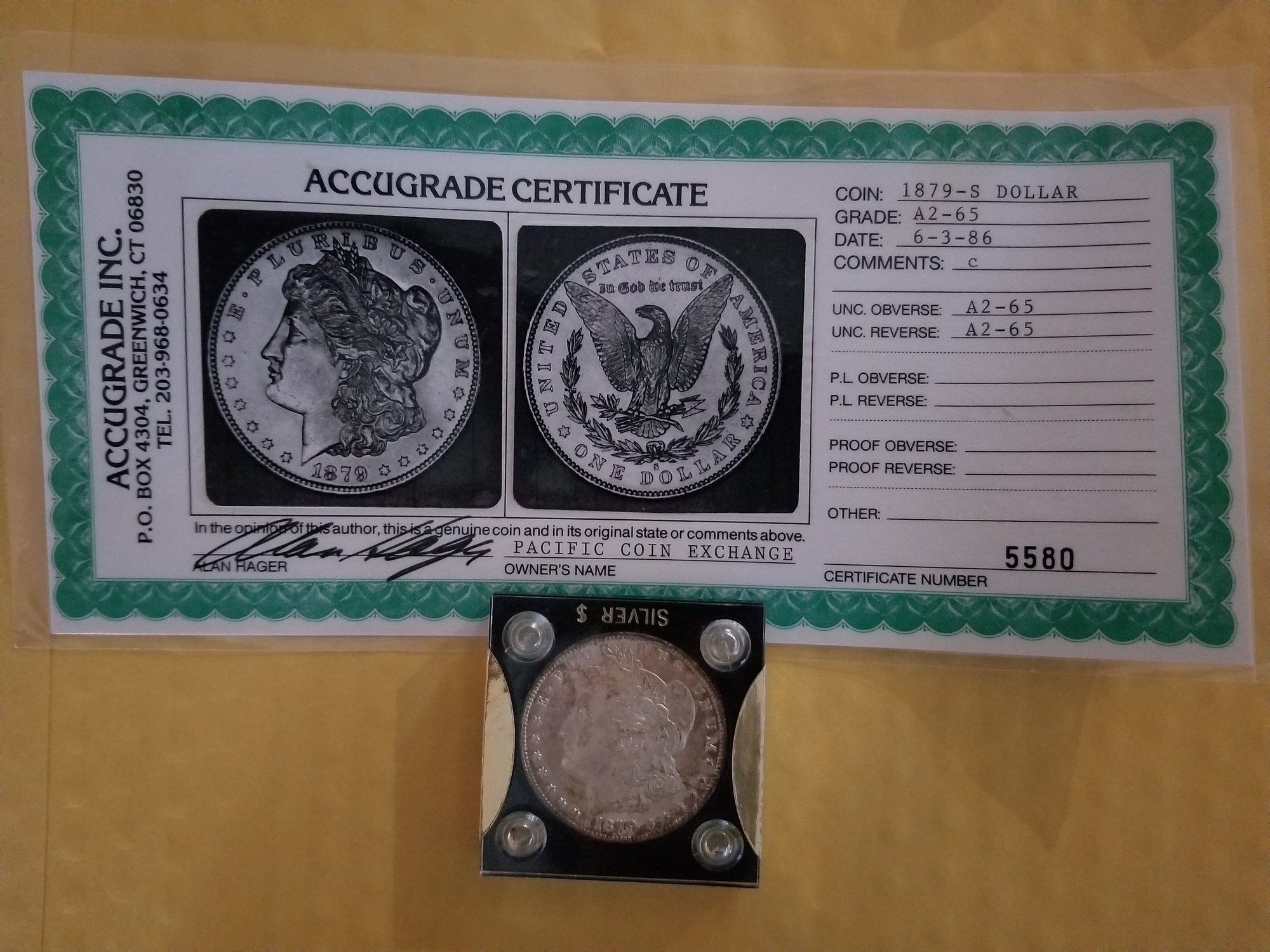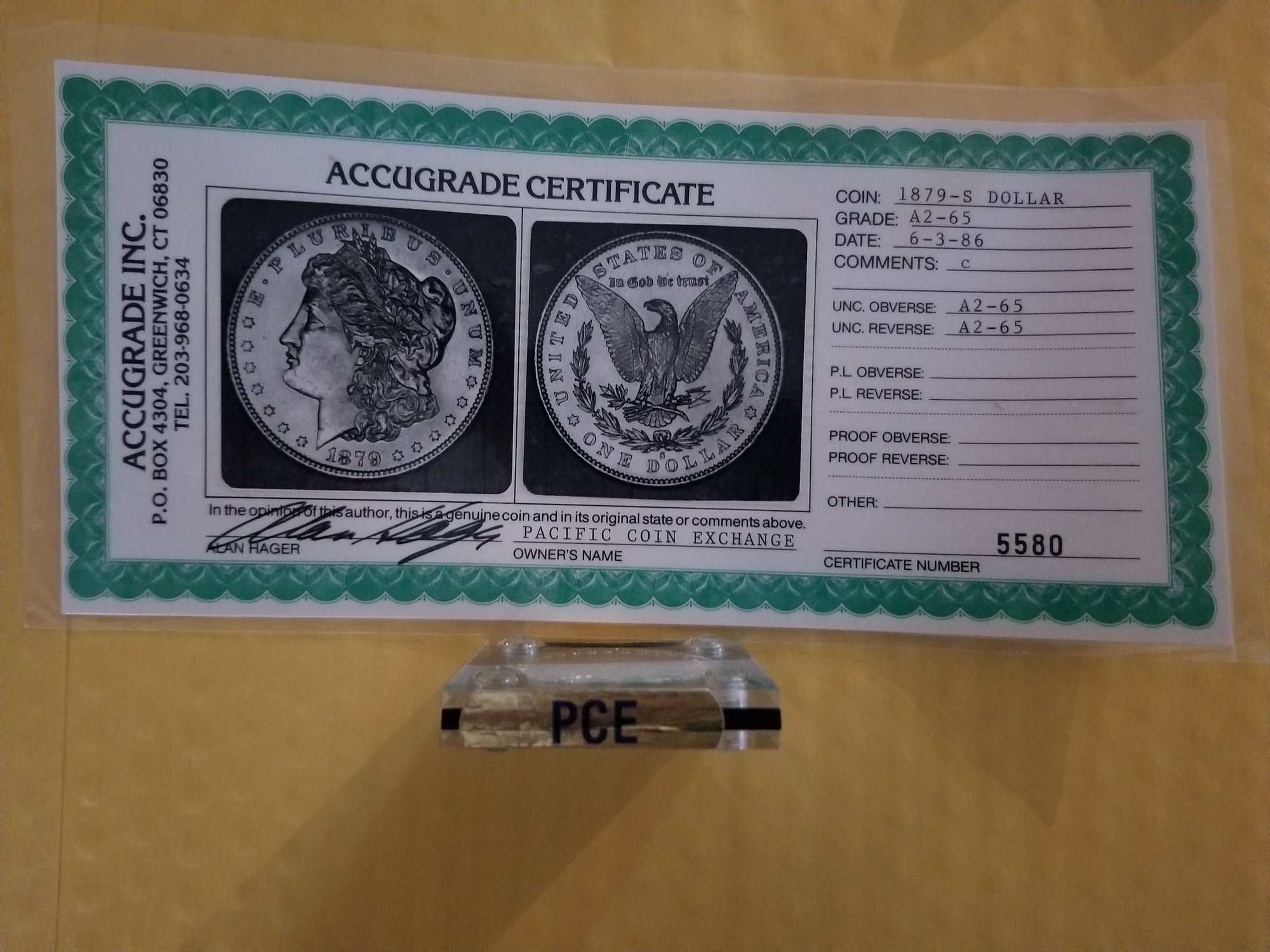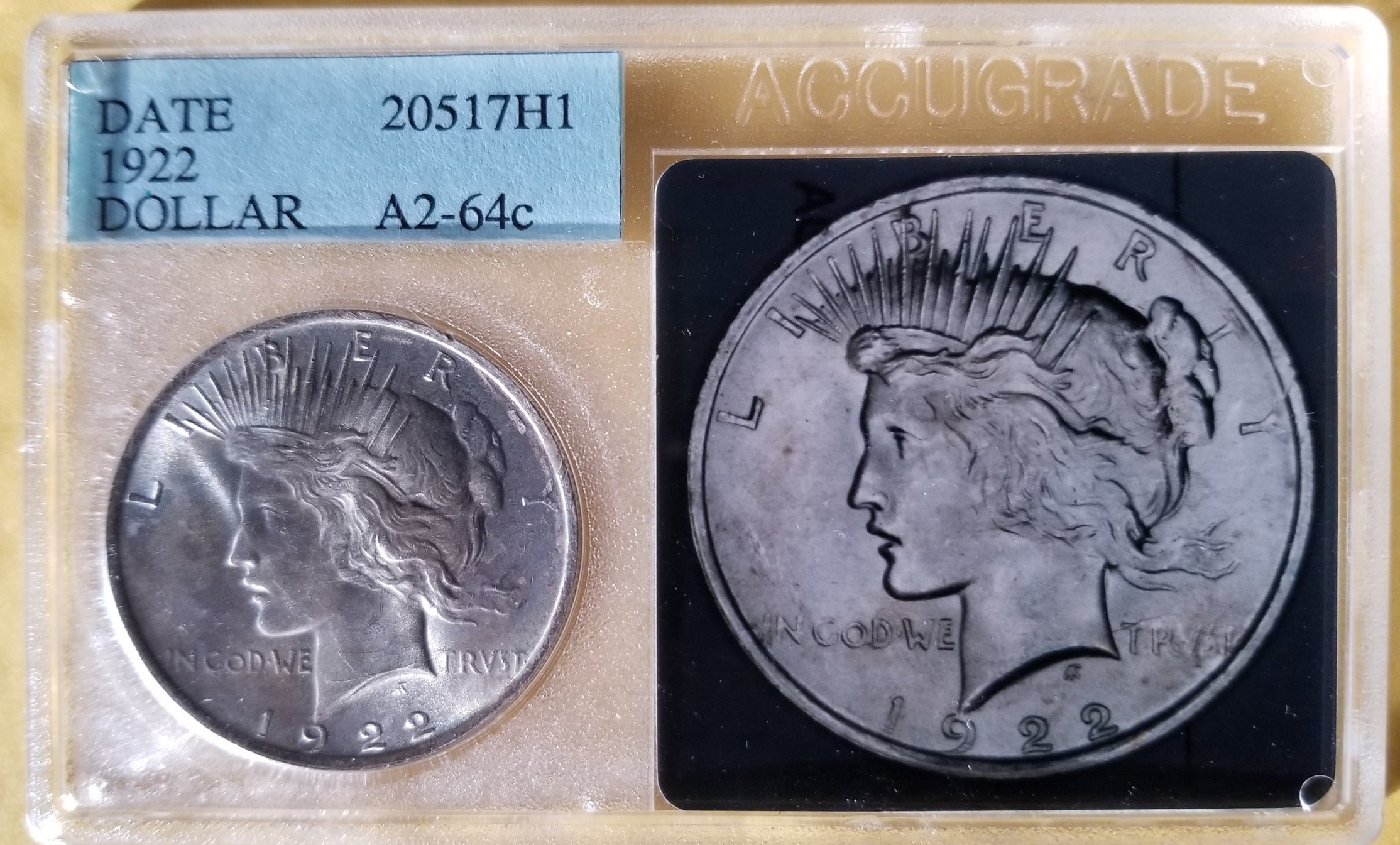Help please: Slab history, Accugrade original certifications and slabs
 Sandman70gt
Posts: 1,022 ✭✭✭✭✭
Sandman70gt
Posts: 1,022 ✭✭✭✭✭
I've been trying to dig up info on slabbing history. I have a pcgs generation slab set and thought it would be cool to carry it out earlier to include some other slabs and certificates prior to pcgs.
Alan Hager of accugrade patented the slab. Pcgs began slabbing in Feb 1986.
So what is the deal with this certificate dated June 1986?
Pacific Coin Exchange has their seal/sticker on the "slab".

Bst transactions with: dimeman, oih82w8, mercurydimeguy, dunerlaw, Lakesammman, 2ltdjorn, MattTheRiley, dpvilla, drddm, CommemKing, Relaxn, Yorkshireman, Cucamongacoin, jtlee321, greencopper, coin22lover, coinfolio, lindedad, spummybum, Leeroybrown, flackthat, BryceM, Surfinxhi, VanHalen, astrorat, robkool, Wingsrule, PennyGuy, al410, Ilikecolor, Southcounty, Namvet69, Commemdude, oreville, Leebone, Rob41281, clarkbar04, cactusjack55, Collectorcoins, sniocsu, coin finder
Comments
That's not a sealed slab it's just a capital plastic holder with a sticker. It was most likely done after the photo certificate was returned to the submitter.
Those cost a couple bucks each even back them...
ANA 50 year/Life Member (now "Emeritus")
Also be careful of saying that the ACG patent was on "the slab".
The ACG patent is a very specific two-compartment photo slab. Remember when reading a patent what matters is not the drawing but rather the words of the claims.
The earliest use anybody's been able to trace of a single compartment small slab is actually South African gold exchange in 1975.
It's unclear whether a single compartment patent was ever filed (not all the records from those days are online). But it would almost certainly have been shot down based on the prior art.
What's a lot of fun is to follow the chain of patents back in time to see the items that were cited by the examiner as prior art, before the ACG patent. And also what was missed...
ANA 50 year/Life Member (now "Emeritus")
@BStrauss3

I realized that was a capitol el cheapo coin holder. I dont know what agc returned the coin in.
I am puzzled as to the June 86 date on the certificate. Did agc not holder in a slab til sometime later after pcgs?
Pcgs must have got around the patent by not including a picture and thereby not using a 2 cavity slab?
Do you know if this is agc's first slab?
PCI and others used this one under license.
Bst transactions with: dimeman, oih82w8, mercurydimeguy, dunerlaw, Lakesammman, 2ltdjorn, MattTheRiley, dpvilla, drddm, CommemKing, Relaxn, Yorkshireman, Cucamongacoin, jtlee321, greencopper, coin22lover, coinfolio, lindedad, spummybum, Leeroybrown, flackthat, BryceM, Surfinxhi, VanHalen, astrorat, robkool, Wingsrule, PennyGuy, al410, Ilikecolor, Southcounty, Namvet69, Commemdude, oreville, Leebone, Rob41281, clarkbar04, cactusjack55, Collectorcoins, sniocsu, coin finder
...just in case this thread garners the attention of some old school slab experts...hopefully somebody can tell me what the hell this one is
The teletrade is easy. They were an early online auction house. As I understand it you actually called us phone number pressed some buttons to enter your ID and your bid.
So what you have in somebody's auction win.
Is it sealed or just a paper insert in a flip?
Heat sealing coins in flips predates slabs.
In fact David Hall one of the founders of PCGS (our hosts), used to heat seal his coins for sale and the sealer bar impressed his name on the seal. I have one.
Before somebody jumps in, yes lots of those early flips contain PVC. Which can damage coins. Emphasis on the can. Not will. If it's been stable since the early 80s it's not likely to wake up one day and say oh I'm PVC let me damage the coin.
ANA 50 year/Life Member (now "Emeritus")
Yes PCI almost certainly licensed the ACG slab. But when Hallmark went belly up, PCI bought all of the assets, filed the name off the slab mold and used it throughout PCI's various (re)incarnations and uses it today.
In early advertisements Alan Hager said that PCGS licensed from ACG.
PCGS says that they did not license the slab from ACG.
Those statements could easily be true, if you recall that the PCGS slab it is a single compartment design.
A smart lawyer might have simply advised paying a license fee to avoid having a new Enterprise tied up in a lawsuit - regardless of whether the lawsuit was frivolous or not, it would have been a major distraction. And given the proclivity of certain individuals to sue, would have turned out to be really good advice.
ANA 50 year/Life Member (now "Emeritus")
Patents and patent law can be very tricky. I dealt with that a lot in a previous business since we had cutting edge designs and led the market in our field. Patent infringement was always a danger, but even more troublesome was guarding our patents from competition. Slabs were/are probably not as big a deal as it was in my industry, but certainly a possible mine field in today's litigation rich society. Cheers, RickO
Especially when we - as lay people - get involved.
Examples of subtlety...
The SEGS patent is a design patent, while the ACG patent is a utility patent.
The diff? A design patent covers the physical appearance of an object. If the patent mentions the top edge label, somebody else couldn't do that. (I don't remember the specific details and it's expired anyway).
A utility patent covers the idea - a plastic holder with compartments for a coin and for a photograph of the coin. You couldn't put the photo on the left side and work around the patent...
Another interesting thing to watch is whether it's been renewed. The ACG patent was allowed to expire (not renewed) either because of oversight or because it wasn't worth the nominal fee. Either way, says how important it was to the business by (IIRC) 1994...
ANA 50 year/Life Member (now "Emeritus")
To answer a question:
https://www.uspto.gov/learning-and-resources/fees-and-payment/uspto-fee-schedule#Patent Maintenance Fee
and https://www.uspto.gov/web/offices/pac/mpep/s2504.html
Fees are required at 3.5 years, 7.5 years and 11.5 years post grant.
Note the implication, if the fee is not paid, then the patent would not be in force beyond 4, 8 or 12 years.
The fee schedule (current) is based on the size of entity filing - even a micro entity would spend over $3,000 to keep the patent in force for the full term. A micro entity has a gross income of under $177,000.
ANA 50 year/Life Member (now "Emeritus")
Is Mr. Hager still alive?
If so, is he still in business?
Yes, he is the "numismatist" behind MACable.
ANA 50 year/Life Member (now "Emeritus")
Condor101 wrote a very nice reference book on slabs. I bought a copy years ago.....nice info.
A lot of Conder's info came directly from AH and some has proven to be incomplete or inaccurate.
Memories fade, especially of mudane routine tasks (do you REALLY remember yesterday's breakfast, or just know you ate it and your memory is supplying the "details" from the other 1,000 times you ate cornflakes?).
Memories from 2002 (when Conder wrote his book) of 1984 were probably better than 2018's member of 1984...
ANA 50 year/Life Member (now "Emeritus")